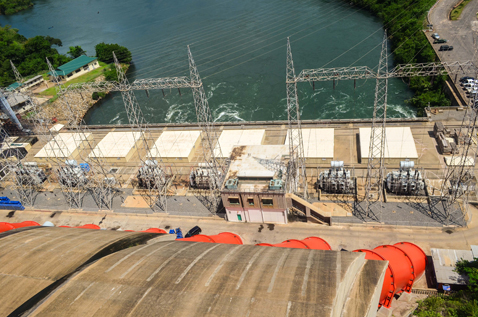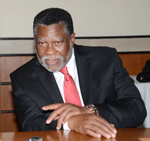
Photo: www.accrareport.com

Chairman
Energy Commission of Ghana
West African country Ghana offers immense opportunities in its power sector and is looking forward to collaborating with Indian entrepreneurs. “We think Indian companies have the capacity to participate and are inviting you because you can,” observed Dr Kwame Ampofo, Chairman, Energy Commission of Ghana. He was interacting with select media entities at the sidelines of the “Powerelec Ghana 2016” formal-launch conference in Mumbai. The event is scheduled to be held at Accra Trade Centre, Ghana during September 1-3, 2016.
Dr Ampofo stressed that Indian companies have opportunities to participate across the power value chain—generation, transmission and distribution. In generation, the direct opportunity is to set up independent power generation plants. Currently, Ghana has an installed power generation capacity of 3,077 mw that includes 56 per cent from hydropower and 44 per cent from thermal plants. Over the next five years itself, Ghana has aimed to add 3,665 mw. While current thermal plants run on gas or liquid oil, the West African country is also exploring the possibility of setting up coal-fired power plants. Despite insignificant domestic coal reserves, Ghana will be in a position to import coal (from Brazil, for instance) and run plants at a much cheaper rates than oil or gas.
Letters of intent to private power producers are being issued vigorously and even Chinese companies are showing keen interest. Currently, IPPs account for a fifth of Ghana’s electricity generation through three projects with one owned by Chinese company Shenzhen Energy Group. Since 2014, Ghana has issued thirteen provisional licences to private power plants (both domestic and foreign) envisaging a total generation capacity of about 6,000 mw.
Hydropower is an area that might providing unyielding in the coming years. Elaborating this, Dr Ampofo said that currently there are three large hydropower plants in the country aggregating 1,636 mw, out of which the 1,074-mw Akosombo project is the largest. These three plants have practically exhausted Ghana’s hydropower potential, insofar as large projects are concerned. However, smaller sites have been identified—Koulbi (68 mw), Awiasam (50 mw), among several others—with a total potential of 1,000 mw. Dr Ampofo explained that every 30 years, Ghana, due to topographical reasons, faces severe drought and every seven years there is a partial drought. Due to this, Ghana, with increasing peak loads envisaged in future, cannot depend on hydropower, inspiring it to evaluate thermal and allied power systems. The duopoly of gas and hydro would need to be dismantled soon, said the energy commission chairman.
Ghana is committed to solar energy and has made firm plans to install as many as 200,000 standalone rooftop solar plants in the next 2-3 years. Dr Ampofo called the participation of Indian companies in setting up solar panel manufacturing facilities that can equip Ghana to avail 200 mw worth of solar modules annually, in the coming years. Incidentally, local companies in Ghana have set up such module-making units, albeit with small capacities of around 25-30 mw per year.
Ghana’s access to electricity is around 74 per cent, a very impressive achievement considering that most African countries have this metric in the range of 12-25 per cent. Ghana not only needs electricity for its own consumption but also to export to other West African nations. Doing business in Ghana therefore implies involvement in a trading hub that could easily open newer markets in the west-African region. Ghana currently has transmission lines of around 330kV—a voltage that needs to be stepped up as higher quantum of power would need to be exported along the west-African corridor. Indian companies that have established expertise—both in manufacturing and erection of power transmission infrastructure—have a particularly interesting market in Ghana, said Dr Ampofo. Some equipment suppliers like BHEL and CG have had a longstanding presence in Ghana, he observed.
When asked if Indian companies could pursue public private partnership in Ghana, Dr Ampofo replied in the affirmative and noted that PPP models would need to be pursued in high-risk areas. Power distribution in remote areas could be one such. In its quest for providing electricity access to all, Ghana would need to reach electricity to remote areas where revenue models could get weak. “Already all the major areas have been covered and now, we are moving into remote areas. It is not economically viable or attractive so the government will go in for PPP model,” explained the top official.
In conclusion, the Chairman, Energy Commission of Ghana averred, “There is a lot of business to do in Ghana, to benefit everybody, and the environment is right.” Urging Indians to act fast, Dr Ampofo observed, “We feel that Indians are too slow in coming even though they would be the companies that we would prefer because of historical ties, because of bilateral relations and because of cultural ties.”
| T&D Losses |
| Even as the Republic of Ghana is aiming at doubling its power generation capacity to meet the project demand, it is also trying to stem line losses in the transmission and distribution space. Dr Kwame said that Ghana’s T&D losses were to the tune of 24 per cent. While technical losses were marginal, much of this loss was on the commercial side. Non-payment of electricity dues and pilferage are issues that would need to be tackled, he said. |











